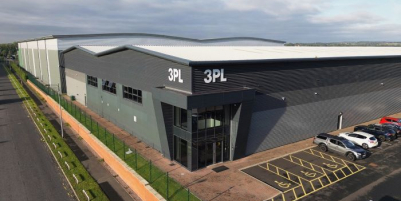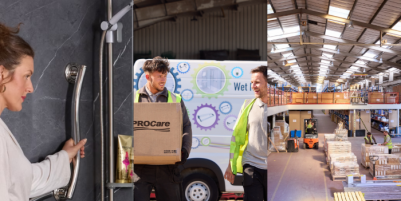-
DATA ANALYSIS – THE FOUNDATION OF EVERY PEAK SEASON - December 5, 2025
-
Creative education specialists Creative Hut give 3PL full marks for onboarding excellence - December 5, 2025
-
Unlimited Industries raises $12M to build the AI construction company that will power America’s future - December 4, 2025
-
Etaily lands strategic investment from Japan’s SMBC – bringing total funding to $24M for Social Commerce enablement platform - December 4, 2025
-
Prism eLogistics and Brand Angels Partnership Gives Brands the Full Package - December 3, 2025
-
New data shows Tesla in danger of losing its way as European consideration to buy Chinese cars jumps 16% in 12 months - December 3, 2025
-
QUECLINK DEVELOPS SATELLITE-ENABLED VEHICLE TRACKING FOR UNINTERRUPTED TRANSPORT MANAGEMENT - December 3, 2025
-
Ocado Ads partners with Epsilon for people-based precision - December 3, 2025
-
Combilift Unveils the 2025 Christmas video “Twelve Days of Christmas” – with a Twist! - December 1, 2025
-
Scurri recognised by G2 for excellence in user experience, support and adoption - December 1, 2025
Fashion retail is a highly competitive, fast-turnover, margin driven business. So how do you create an agile, ‘demand-responsive’ fulfilment operation fit for tomorrow’s constantly changing seasonal challenges? By Chris More, head of Sales for Ferag’s UK and Nordic regions
Retail businesses in the fashion sector are having to think hard and fast about how they compete on range, stock turns, availability in store as well as online, speed of fulfilment, returns & refunds – and importantly, still be in a position to offer a seamless omni-channel experience at a price that generates optimum sales and maximises margin.
Performance in the warehouse at peak has never been more critical. Seasonal promotions, along with Christmas, summer sales and Black Friday events are increasingly vital to business profitability, but they create massive surges in demand and a constant turnaround of ranges, all of which place a heavy strain on the fulfilment operation.
What’s more, labour is no longer the low-cost flexible answer to ratchetting up warehouse performance it once was. Finding reliable labour when you need it has become a serious issue that can impact sales and future growth. Hence many forward-thinking businesses are turning to flexible, low-Capex automation, to not simply just cope with demand at peak, but to build in flexible capacity, reduce risk and to offer capabilities that secure future sales and support business growth by being ‘demand-responsive’.
Potential opportunities
A vast array of new, highly flexible, low-Capex technology is available from a growing list of manufacturers. Goods-to-person picking operations using Autonomous Mobile Robots (AMRs) together with advanced pick-to-light technology can transform pick performance, boosting throughput and accuracy with hugely reduced dependency on labour. The same technology can also be used to speed up returns processing and can be scaled up or down by simply adding or redeploying robots.
Conveyor systems, sorters and overhead pouch technology can also be deployed seamlessly, using smart software that allows total control for real-time order prioritisation – optimising fulfilment during peak periods.
Low-cost, high flexibility
These relatively low-cost, flexible, high-performance solutions present a huge opportunity to SMEs, allowing them to leverage technology to their advantage over larger rivals by competing on cost-effective, fast fulfilment with later cut-offs and ultra-reliable performance that can support sales growth. A stepped approach to applying automation can deliver significant cost-savings, addressing bottlenecks and heavily manual operations in order of priority or need.
Many larger retail fashion brands may benefit from advanced overhead pouch sorter systems, such as Ferag’s market leading Skyfall technology, which uses available overhead space to convey, buffer and sort both hanging garments and flat items, such as shoes and flat pack goods, at processing speeds of up to 25,000 units per hour. The same high-speed pouch sorter system used for fulfilling ecommerce orders can also be deployed to create store friendly sequenced consignments for high-street shops.
Building scale
Interestingly, businesses may be able create the necessary scale for automation by consolidating inventory into one omni-channel facility that serves both high street stores and ecommerce channels. Pooling stock in this way not only offers the scale and throughput needed for automation, but it also holds the potential to create huge flexibility, where fashion goods flow quickly and smoothly to satisfy demand, whether that be on the high street, click n’ collect, or ecommerce. With this agility, there are no longer complications around moving stock between locations or being out of stock in one channel only to find excess stock in another.
In addition, a single automated omni-channel facility could, with the right technology, handle returns too. Processing items swiftly and buffering them to make them immediately available for sale again (via whichever channel is best suited) has the potential to increase sales and may reduce the need for markdowns. Much depends upon acting quickly, before a product loses its fashion moment.
Engine for growth
Consolidating inventory in a single, highly automated omni-channel facility can drive greater efficiencies, improve productivity, and boost responsiveness – creating an engine for growth that has more opportunities for sales with higher margins.
Of course, bringing together best-of-breed technology requires the expert help of an independent integrator, one that is free to select and specify the most appropriate solution. Ferag’s highly versatile proprietary software ferag.doWarehouse, combines WMS, WES and WCS into a single platform giving it the power to connect, control and manage a whole world of smart warehouse technologies from different suppliers, making Ferag the leading independent integrator for SMEs keen to take their first-step into warehouse automation.
More information on Ferag’s integrated solutions for SMEs is available at https://www.ferag.com/en/ or #perfectmatch

































